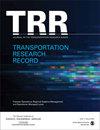美国机场属性在COVID-19大流行输出响应中的作用:基于差中差法的随机前沿分析
IF 1.8
4区 工程技术
Q3 ENGINEERING, CIVIL
引用次数: 0
摘要
机场对经济发展、人员和服务的互联互通以及货物流动至关重要。此外,机场是应对COVID-19的关键基础设施。在本研究中,我们试图研究COVID-19大流行对美国机场产出的影响。具体来说,我们的分析侧重于机场规模、传统航空公司的枢纽和多机场系统对输出的影响。利用2019年和2020年美国59个枢纽机场的数据,并采用差中差法进行随机前沿分析,我们发现,与中型枢纽机场相比,大型枢纽机场的运营下降幅度更大;作为三大传统航空公司主要枢纽的机场,可能由于更多地接触国际市场,其产出下降幅度更大;在多机场系统和独立机场之间,输出减少没有显著差异。无论疫情的影响如何,大型机场、作为传统航空公司枢纽的机场,以及属于多机场系统的机场,平均效率都高于各自的机场。疫情对机场产出的初步影响,揭示了机场未来可能面临的需求结构性变化。本文章由计算机程序翻译,如有差异,请以英文原文为准。
Role of U.S. Airports’ Attributes in the Output Response to the COVID-19 Pandemic: A Stochastic Frontier Analysis with the Difference-in-Differences Method
Airports are vital to economic development, the connectivity of people and services, and the movement of goods. Moreover, airports are critical infrastructure for the COVID-19 response. In this study, we attempt to examine the impacts of the COVID-19 pandemic on U.S. airports’ outputs. Specifically, our analysis focuses on the impact on output with respect to airport size, legacy carriers’ hubs, and multi-airport systems. Using the data on 59 U.S. hub airports in 2019 and 2020 and a stochastic frontier analysis with the difference-in-differences method, we find that large hub airports faced a sharper decline in their operations compared with medium hub airports; airports serving as a major hub to the three legacy carriers experienced larger output declines possibly as a result of their greater exposure to international markets; there is no significant difference in output decreases between airports in a multi-airport system and standalone airports. Regardless of the pandemic impact, large airports, airports serving as a hub of the legacy carriers, and airports belonging to a multi-airport system are on average more efficient than their respective counterparts. The initial impact of the pandemic on airports’ output sheds light on the likely structural changes in demand that airports will face in the future.
求助全文
通过发布文献求助,成功后即可免费获取论文全文。
去求助
来源期刊

Transportation Research Record
工程技术-工程:土木
CiteScore
3.20
自引率
11.80%
发文量
918
审稿时长
4.2 months
期刊介绍:
Transportation Research Record: Journal of the Transportation Research Board is one of the most cited and prolific transportation journals in the world, offering unparalleled depth and breadth in the coverage of transportation-related topics. The TRR publishes approximately 70 issues annually of outstanding, peer-reviewed papers presenting research findings in policy, planning, administration, economics and financing, operations, construction, design, maintenance, safety, and more, for all modes of transportation. This site provides electronic access to a full compilation of papers since the 1996 series.
 求助内容:
求助内容: 应助结果提醒方式:
应助结果提醒方式:


